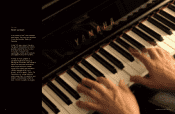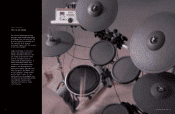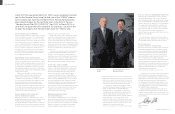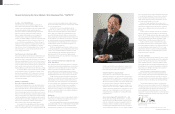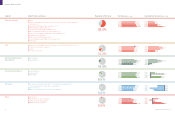Yamaha 2007 Annual Report Download - page 13
Download and view the complete annual report
Please find page 13 of the 2007 Yamaha annual report below. You can navigate through the pages in the report by either clicking on the pages listed below, or by using the keyword search tool below to find specific information within the annual report.
Yamaha Annual Report 2007 2423
Review of Operations lMusical Instruments
segmentation of digital pianos is helping to stimulate general
demand for keyboards, with the market for keyboard
instruments showing a clear trend toward polarization
between the high-value-added and low-priced segments.
Musical instrument retailers in Japan are also adapting to
market trends by offering more music classes and individual
lessons. Hence, the Japanese market for musical
instruments now looks likely to expand gently over the
coming years, led by a revival in interest in music and in
playing instruments, particularly among the baby boom and
younger generations.
In the United States, the effects of higher interest
rates, depressed consumer spending and stalled housing
starts are continuing to squeeze the market, particularly for
large keyboards. The downturn in retail sales of musical
instruments is closely correlated with macroeconomic
trends, with a certain time lag. One feature of the US market
is that the chains of large instrument retailers now account
for a large proportion of sales, making Yamaha’s business
with these stores all the more important going forward.
However, the overall US market for musical instruments
has still grown over the past ten years, and Yamaha
expects the long-term trend to remain one of expansion.
In Europe, retail sales of musical instruments have
begun growing again in the critical market of Germany
amid a macroeconomic recovery. A key future issue for
Yamaha is the development of effective market measures
to further emphasize the strengths of the Yamaha brand in
order to counter a market trend toward the introduction of
own-branded instruments by leading retailers.
The market for musical instruments on the Chinese
mainland is estimated at around ¥60 billion, of which about
two-thirds represents demand for pianos. Although the
market has cooled slightly of late, demand is expected to
grow further over the medium and long term.
Markets in Russia and Eastern Europe are projected to
grow rapidly going forward now that political and economic
conditions are relatively stable.
“YGP2010” targets and policies
Under the “YGP2010” medium-term business plan, the
segment targets for fiscal 2010 are ¥360 billion in sales and
¥30 billion in operating income. Achievement of these targets
is partly a matter of extending measures begun under the
“YSD50” plan. New policy initiatives are outlined below.
Generating growth in the piano business by
promoting a customer-oriented product strategy
In the piano business, Yamaha is following a “Total Piano
Strategy” that aims to develop a range of pianos to cater to
different customer needs. This involves developing an even
stronger position in both acoustic and digital technologies
while at the same time trying to blend such technologies to
create a complete, seamless and fully customer-oriented
range of products. In doing so, Yamaha expects to cater to
a broad range of market requirements in the modern age. In
acoustic pianos, one of the basic aims is to realize a further
evolution in the instrument to take it to new heights.
Meanwhile, Yamaha is also looking to create hybrid pianos
based on new concepts that are not tied to traditional ideas,
such as pianos for more casual use by different levels of
players for varied applications, as well as pianos where the
status of cosmetic design is elevated, and pianos in which
priority is placed on the instrument’s setting or placement. In
this way, Yamaha can meet diverse market needs.
Gaining market share in guitars through
improved competitiveness
The global market for guitars is growing and is currently
estimated in annual terms at ¥200 billion. Yamaha’s guitar
business is small compared with the scale of this market.
Although Yamaha has developed a name in acoustic
guitars, the Company’s market share in electric guitars
remains low. Yamaha aims to increase market share while
rebuilding based on traditional strengths.
Currently Yamaha is focusing on the electric acoustic
guitar sector. Growth in North America in recent years has
been remarkable, to the extent that the market for these
guitars is now worth more than half that for pure acoustic
guitars in value terms. Yamaha expects this trend to spread
to the rest of the global market in due course. Yamaha
plans to introduce new electric acoustic guitar models that
exemplify the qualities expected of the Yamaha brand. By
combining acoustic guitar technologies, which control the
sound based on the characteristics of the wood used, with
digital pick-ups, DSP* and other digital technologies,
Yamaha plans to develop new electric acoustic guitars that
can create a large sound without losing any of the sound
qualities inherent in a good acoustic guitar.
Currently Yamaha manufactures high-end guitar models
in Japan, while the entry-level instruments are produced in
Indonesia and China. Aggressive manufacturing reforms
remain underway across each of these production bases.
Yamaha is also investing proactively in artist services to
develop stronger relationships with leading musicians. In
the United States, Yamaha has expanded its R&D facilities
to the local subsidiary Yamaha Artist Services Hollywood,
focusing resources into artist relations there. Yamaha is also
upgrading efforts to build relations with music professionals
through a London-based team specializing in guitars. In
Japan, the aim is to develop stronger and more coordinated
links with sales divisions.
New integrated management of music
entertainment business
The “YGP2010” plan mainly targets growth in sectors related
to “sound, music and audio” business domain. In June
2007, Yamaha established a new management company,
Yamaha Music Entertainment Holdings, Inc. (YMEH), to
oversee operations in all music entertainment businesses
operated by the Yamaha Group and the Yamaha Music
Foundation. All operations in this field are being realigned
and consolidated under YMEH into six separate operating
companies. By building more effective and flexible systems,
YMEH will manage and expand Yamaha music entertainment-
related operations. These span a wide variety of areas,
including various support activities for amateur musicians
within the Yamaha Group; artist scouting, nurturing and
supporting creative work of music artists; the market
supply of music entertainment works to the market through
various media; and Yamaha’s music publishing business.
The guiding concept for the future development of
Yamaha’s music entertainment business will be to foster
the creation of music that can contribute to society by
providing fresh ‘kando’* along with cultural enrichment.
Targeting further growth in professional
audio equipment business through
expansion into new sectors
Yamaha’s PM1D and PM5D digital mixers are recognized
within the industry as setting global benchmarks in this
field. Such products have helped lead the transition from
analog technology to the world of digital. Yamaha is
working to solidify its position as the world leader in digital
mixers by continuing to exploit the Company’s strengths in
digital and network technologies. Alongside this, Yamaha
also aims to expand by developing services as a system
solutions provider. This focuses on catering to market
demand for systemized audio equipment solutions, backed
up by product design and installation proposals, and full
technical support. Another target market segment for
Yamaha is commercial installed sound systems for
applications other than music in venues such as exhibition
spaces, schools and hotels. This is another major market
with the potential to support future business growth.
Music production synthesizer MM6
* Digital Signal Processor (Processing) (DSP) refers to
general digital signal-processing technologies developed
by Yamaha, including various original technologies for
processing digital audio and music. Practical applications
include sound field controls in AV equipment, effecters
used in professional mixing consoles, mobile phone
sound generation and 3D sound technologies.
Yamaha music lessons for adults
Yamaha music school
Upright piano b series
This recently launched in Europe entry-level model is
proving popular.
Electric acoustic guitar CPX900
Electric acoustic guitars are adaptable enough to be
perfect for performing anywhere from the concert
hall to the street.
UtacchaTM, true tone content
distribution service
Portable PA system STAGEPASTM 500
Digital mixing console M7CL-48
Digital mixing consoles are bringing the dramatic
improvements in sound that are possible with digital
technology to many live music venues the world
over, including many churches in the United States.
A broad range of users from the digital beginner to
the professional sound engineer can use this prod-
uct for live mixing. Digital mixers such as this have
sold well for Yamaha in the United States and
Europe, driving the growth in overall sales of profes-
sional audio equipment.
Digital piano MODUSTM H01
This new-concept electronic piano has a simple but highly
sophisticated design. Including all the first-rate basic per-
formance characteristics expected of a Yamaha electronic
piano, it also adds value to any room. Yamaha is marketing
this model through interior design shops and other new
sales channels as well as musical instrument retailers.
* ‘Kando’ (is a Japanese word that) signifies an
inspired state of mind.
(For further details, please refer to the “Special Feature:
Dynamic Growth Expected from Commercial Audio
Equipment Business” section on pp.17-18.)


